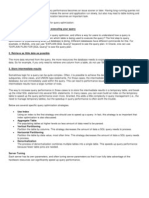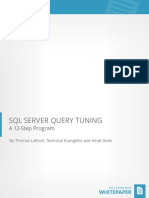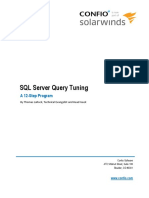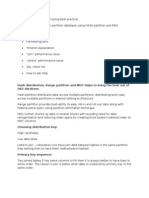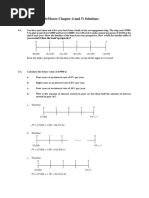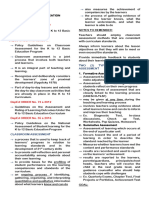0 ratings0% found this document useful (0 votes)
7 viewsSQL Query optimization techniques
The document outlines 10 essential SQL query optimization techniques for data scientists to enhance database performance. Key strategies include index optimization, query refactoring, and efficient use of joins and data types. Additionally, it emphasizes the importance of analyzing query execution plans and leveraging temporary tables, materialized views, and caching mechanisms.
Uploaded by
Abdel-Aziz SOUMAHOROCopyright
© © All Rights Reserved
We take content rights seriously. If you suspect this is your content, claim it here.
Available Formats
Download as PDF, TXT or read online on Scribd
0 ratings0% found this document useful (0 votes)
7 viewsSQL Query optimization techniques
The document outlines 10 essential SQL query optimization techniques for data scientists to enhance database performance. Key strategies include index optimization, query refactoring, and efficient use of joins and data types. Additionally, it emphasizes the importance of analyzing query execution plans and leveraging temporary tables, materialized views, and caching mechanisms.
Uploaded by
Abdel-Aziz SOUMAHOROCopyright
© © All Rights Reserved
We take content rights seriously. If you suspect this is your content, claim it here.
Available Formats
Download as PDF, TXT or read online on Scribd
You are on page 1/ 12
10
Advanced SQL
Query Optimization
Techniques
Every Data Scientist Must Know!
like share comment
Struggling with slow SQL
queries?
As a data scientist, optimizing your
database performance is crucial for
efficiency and scalability. Here are
10 proven SQL query optimization
techniques that will take your skills
to the next level!
1
Index Optimization
Ensure indexes are created on columns
that are frequently used in 'WHERE'
clauses, 'JOIN' conditions and as part of
'ORDER BY' clauses.
Use composite indexes for columns that
are frequently queried together.
Regularly analyze and rebuild fragmented
indexes.
2
Query Refactoring
Break complex queries into simpler
subqueries or use common table
expressions (CTEs).
Avoid unnecessary columns in the
'SELECT' clause to reduce the data
processed.
3
Join Optimization
Use the appropriate type of join (INNER
JOIN, LEFT JOIN, etc.) based on the
requirements.
Ensure join columns are indexed to speed
up the join operation.
Consider the join order, starting with the
smallest table.
4
Use of Proper Data Types
Choose the most efficient data type for
your columns to reduce storage and
improve performance.
Avoid using 'SELECT *', specify only the
columns you need.
5
Query Execution Plan
Analysis
Use tools like 'EXPLAIN or 'EXPLAIN
PLAN' to analyze how the database
executes a query.
Look for full table scans, inefficient joins,
or unnecessary sorting operations.
6
Temporary Tables and
Materialized Views
Use temporary tables to store
intermediate results that are reused
multiple times in complex queries.
Use materialized views to store
precomputed results of expensive
queries.
7
Efficient Use of
Subqueries and CTEs
Replace correlated subqueries with joins
when possible to avoid repeated
execution.
Use CTEs to improve readability and
reusability, and sometimes performance,
of complex queries.
8
Optimization of
Aggregate Functions
Use indexed columns in 'GROUP BY'
clauses to speed up aggregation.
Consider using window functions for
complex aggregations instead of
traditional 'GROUP BY'.
9
Avoiding Functions in
Predicates
Avoid using functions on columns in the
'WHERE' clause as it can prevent the use
of indexes.
Rewrite conditions to allow the use of
indexes.
10
Parameter Sniffing and
Query Caching
Be aware of parameter sniffing issues
where SQL Server caches execution plans
based on initial parameter values.
Use query hints or option recompile to
address specific performance issues.
Take advantage of query caching
mechanisms where appropriate to reuse
execution plans.
You might also like
- Share OFAD 30013 KEYBOARDING AND DOCUMENTS PROCESSING WITH LABORATORYNo ratings yetShare OFAD 30013 KEYBOARDING AND DOCUMENTS PROCESSING WITH LABORATORY62 pages
- Munk - 2008 - Financial Asset Pricing Theory100% (2)Munk - 2008 - Financial Asset Pricing Theory360 pages
- 6 tips for better sql query optimization (with example code)No ratings yet6 tips for better sql query optimization (with example code)4 pages
- SQL Performance Tuning: Ch.V.N.Sanyasi Rao, Tiruveedula Gopi KrishnaNo ratings yetSQL Performance Tuning: Ch.V.N.Sanyasi Rao, Tiruveedula Gopi Krishna3 pages
- Top 10 SQL Performance Optimization TechniquesNo ratings yetTop 10 SQL Performance Optimization Techniques1 page
- advanced query optimization techniques in sql _ by darshan lunagariya _ mediumNo ratings yetadvanced query optimization techniques in sql _ by darshan lunagariya _ medium7 pages
- Buy Quest Products Buy Guy'S Book Buy Quest Products: Top Tips For Oracle SQL TuningNo ratings yetBuy Quest Products Buy Guy'S Book Buy Quest Products: Top Tips For Oracle SQL Tuning41 pages
- optimizing sql query performance_ a comprehensive guide _ by taran kaur _ women in technology _ mediumNo ratings yetoptimizing sql query performance_ a comprehensive guide _ by taran kaur _ women in technology _ medium15 pages
- Buy Quest Products Buy Guy'S Book Buy Quest Products: Top Tips For Oracle SQL TuningNo ratings yetBuy Quest Products Buy Guy'S Book Buy Quest Products: Top Tips For Oracle SQL Tuning41 pages
- mastering sql query performance_ an in-depth optimization g…No ratings yetmastering sql query performance_ an in-depth optimization g…6 pages
- 12 sql query optimization best practices for cloud databasesNo ratings yet12 sql query optimization best practices for cloud databases9 pages
- SQL Server Query Optimization Techniques - Tips For Writing Efficient and Faster QueriesNo ratings yetSQL Server Query Optimization Techniques - Tips For Writing Efficient and Faster Queries4 pages
- SQL Server Query Optimization Techniques - Tips For Writing Efficient and Faster QueriesNo ratings yetSQL Server Query Optimization Techniques - Tips For Writing Efficient and Faster Queries4 pages
- 1403 Confio SQL Server Tuning Infographics 8 5x11No ratings yet1403 Confio SQL Server Tuning Infographics 8 5x111 page
- SQL SERVER 2005/2008 Performance Tuning For The Developer: Michelle GutzaitNo ratings yetSQL SERVER 2005/2008 Performance Tuning For The Developer: Michelle Gutzait112 pages
- Oracle SQL High Performance Tuning: Guy Harrison Director, R&D Melbourne100% (1)Oracle SQL High Performance Tuning: Guy Harrison Director, R&D Melbourne56 pages
- 12 Tips for Optimizing SQL Queries for Faster Performance _ by Sarang S. Babu _ Learning SQL _ MediumNo ratings yet12 Tips for Optimizing SQL Queries for Faster Performance _ by Sarang S. Babu _ Learning SQL _ Medium13 pages
- An Expert Guide To SQL Server Performance Tuning PDFNo ratings yetAn Expert Guide To SQL Server Performance Tuning PDF10 pages
- sql indexes - advanced sql _ bipp analyticsNo ratings yetsql indexes - advanced sql _ bipp analytics5 pages
- SQL Query Tuning and Safe Procedure Writing: Submitted By: - Aman SharmaNo ratings yetSQL Query Tuning and Safe Procedure Writing: Submitted By: - Aman Sharma9 pages
- SQL Server Query Optimization Techniques PDFNo ratings yetSQL Server Query Optimization Techniques PDF9 pages
- Snowflake Query Optimization Techniques SnowNo ratings yetSnowflake Query Optimization Techniques Snow13 pages
- (1) sql performance tuning - best practices _ examples _ linkedinNo ratings yet(1) sql performance tuning - best practices _ examples _ linkedin4 pages
- Chapter 2 - Optimizing The Performance of QueriesNo ratings yetChapter 2 - Optimizing The Performance of Queries67 pages
- Advanced SQL Performance Tuning: Optimize Your Database WorkloadsFrom EverandAdvanced SQL Performance Tuning: Optimize Your Database WorkloadsNo ratings yet
- The SQL Workshop: Learn to create, manipulate and secure data and manage relational databases with SQLFrom EverandThe SQL Workshop: Learn to create, manipulate and secure data and manage relational databases with SQLNo ratings yet
- deloitte-nl-risk-deloitte-cyber-overviewNo ratings yetdeloitte-nl-risk-deloitte-cyber-overview19 pages
- 091017-Printing-Version-PBA-Guidelines-1No ratings yet091017-Printing-Version-PBA-Guidelines-113 pages
- Chapter 3 Action, Personnel, and Cultural ControlsNo ratings yetChapter 3 Action, Personnel, and Cultural Controls15 pages
- Automation Defect Detection System ReportNo ratings yetAutomation Defect Detection System Report38 pages
- Installation, Operation, and Service Manual: Tempstar Series Door-Type DishmachinesNo ratings yetInstallation, Operation, and Service Manual: Tempstar Series Door-Type Dishmachines92 pages
- Instant Access to Survey Data Harmonization in the Social Sciences Irina Tomescu-Dubrow ebook Full Chapters100% (4)Instant Access to Survey Data Harmonization in the Social Sciences Irina Tomescu-Dubrow ebook Full Chapters66 pages
- YJACK - State-Of-The-Art Technology of YJACK in Bi-Directional Pile TestNo ratings yetYJACK - State-Of-The-Art Technology of YJACK in Bi-Directional Pile Test6 pages
- Practice Paper Class-Xii Sub-Comp - SC Time:1 HR F.M: 35 Section-ANo ratings yetPractice Paper Class-Xii Sub-Comp - SC Time:1 HR F.M: 35 Section-A5 pages
- CLoud Computing Lab 11 On 6 And13 - 01-2022No ratings yetCLoud Computing Lab 11 On 6 And13 - 01-202221 pages
- Water Expands When It Freezes Ice Is Less Dense When It Floats If The Increase in Volume Is 4 - Google SearchNo ratings yetWater Expands When It Freezes Ice Is Less Dense When It Floats If The Increase in Volume Is 4 - Google Search1 page
- Ch01 - The Role of Accounting in BusinessNo ratings yetCh01 - The Role of Accounting in Business52 pages
- STIHL RMI 632 P Owners Instruction ManualNo ratings yetSTIHL RMI 632 P Owners Instruction Manual192 pages
- Engine Assembly (3Zz Fe/4Zz Fe) : InspectionNo ratings yetEngine Assembly (3Zz Fe/4Zz Fe) : Inspection4 pages












